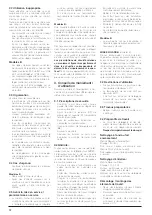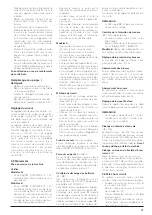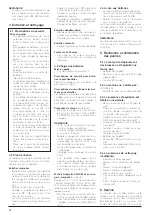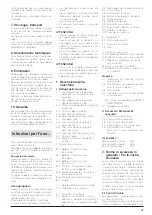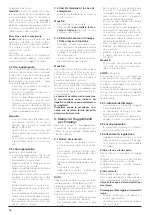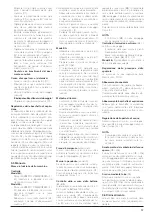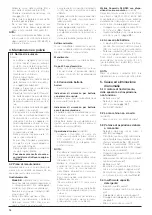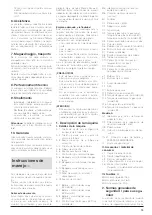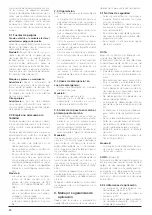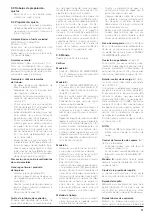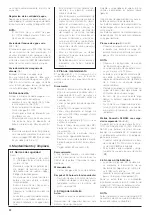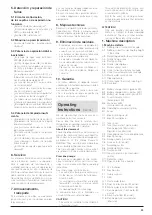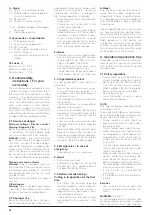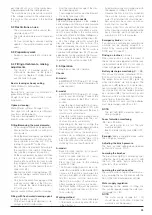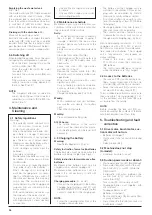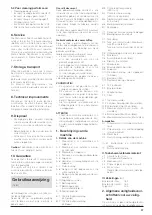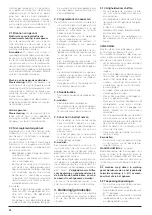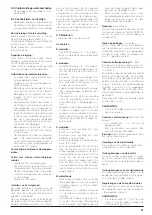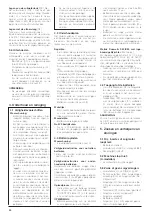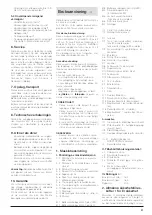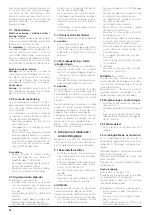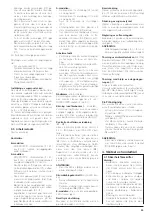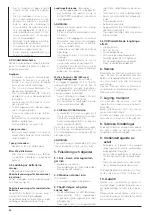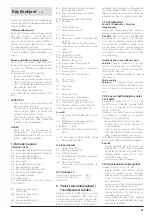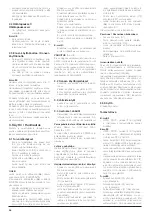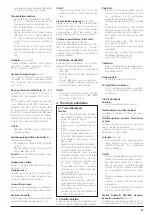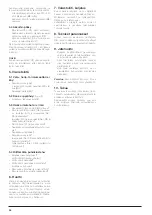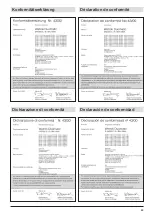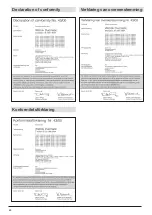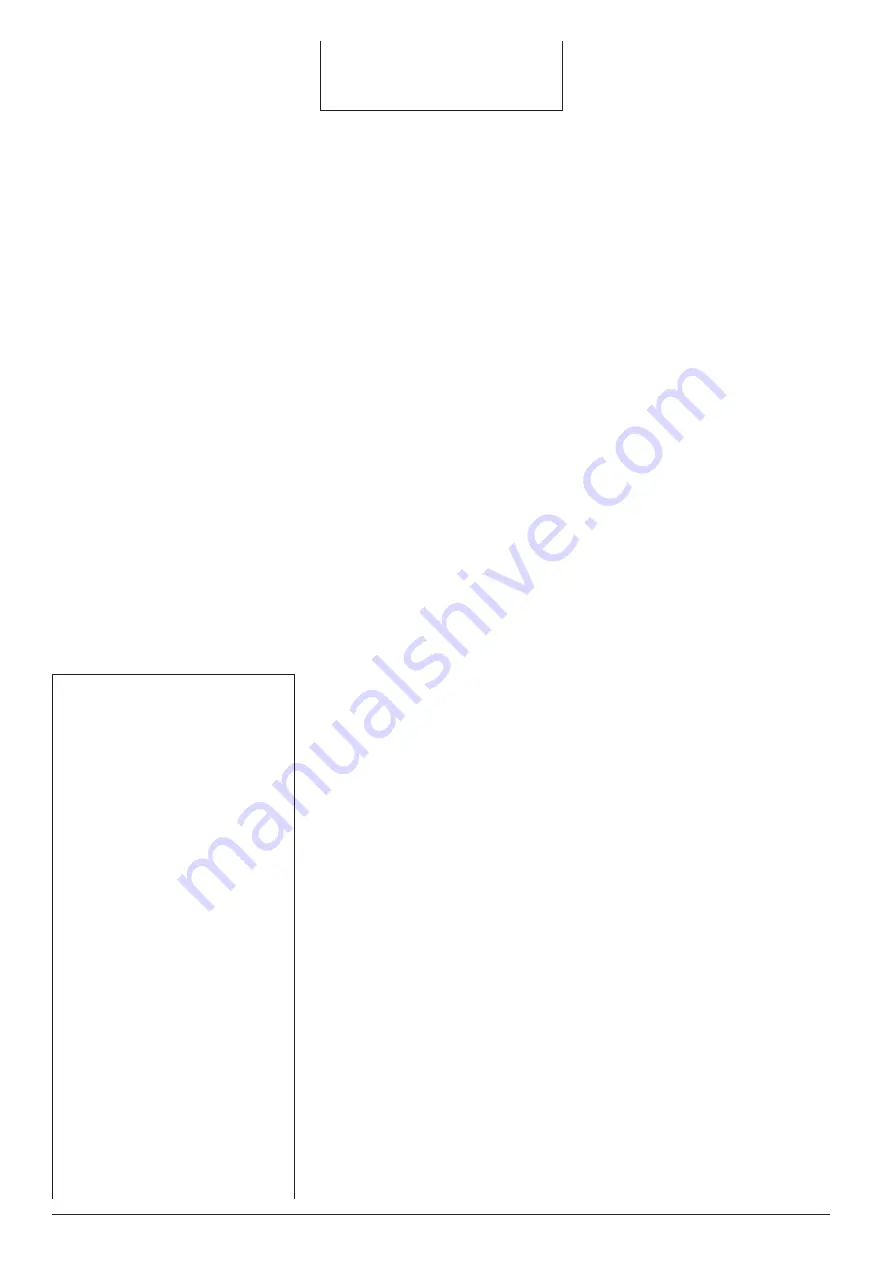
26
Emptying the waste water tank
(G3 / G6)
The waste water tank (G3 / G6) is equipped
with an electronic shut-off device. When
the maximum level is reached by water or
foam, the suction motor will be automatical-
ly switched off (LED B4 blinks). Always
switch off the machine before emptying.
Draining with the drain hose
(A9)
Rinse out tank with clean water.
Each time the water is changed, the waste
water tank (G3 / G6) must be completely
emptied. Every time that the water is chan-
ged, the fresh water filter (G5) must be remo-
ved and be rinsed out under running water.
3.6 Switching off
When leaving the machine, it must be secu-
red against any unintentional movement.
– Raise the brush housing (D4) and the
suction nozzles (A5 / D9).
– Close the water feed with the water
dosage (A7 / I2).
– Turn back the main key switch (B5) and
remove it.
– If the machine is positioned on a sloping
surface, lower the working elements to
the floor. See Point 3.1
NOTE:
– The weighted effective acceleration
value to which the arm of the operator is
subjected (according to ISO 5349) lies
below 2.5 m/s
2
.
4. Maintenance and
Cleaning
4.1 Safety regulations
Warning:
– The batteries contain sulphuric acid.
Do not swallow! Corrosive. Avoid
contact with skin and eyes.
– When the batteries are being char-
ged, there is a danger of explosion
due to the formation of oxy-hydrogen
gas. There is a risk of serious injury!
– Never work near the batteries with an
open flame or glowing objects.
– Avoid creating any sparks near the
batteries!
– Absolutely no smoking.
– Maintenance-free batteries must not
be opened. It is not necessary to add
distilled water.
– Do not place any conducting objects
(e.g., metal tools) on the batteries.
– When cleaning and servicing the
machine, changing parts or conver-
ting to a different function, switch off
the drive and remove the main key
switch key. The machine must be
disconnected from the charging unit
plug and from any connection to the
mains supply.
With mains-operated machines, pull
the plug out of the mains socket.
– The machine must not be cleaned
with high-pressure / steam cleaners
or liquid jets.
– Only use Wetrok original spare parts
for repairs.
– Only use Wetrok original accessories
and working elements.
4.2 Maintenance schedule
Maintenance and care are important pre-
conditions for the satisfactory function and
long service life of the machine.
Daily:
– E - model: Inspect the mains connection
lines for signs of damage or aging. If
damage is detected, the line must be
replaced before any further use of the
machine.
– Empty and rinse out the fresh water tank
(G4).
– Clean the fresh water filter (G5).
– Completely empty the waste water tank
(G3 / G6) and thoroughly rinse with
clean water.
– Leave tank cover (D1) open when
machine is not in use.
– Remove the suction nozzle (A5 / D9).
Clean the suction channel and the sque-
egee blades.
– Wipe down the machine with a clean,
slightly damp cloth.
– Carry out battery inspection and mainte-
nance as detailed in the battery inspec-
tion booklet.
– Charge the batteries (see Point 4.3).
Weekly:
– With conventional wet cell batteries,
measure the acid density of all battery
cells.
Check the distilled water.
Monthly:
– Clean and grease battery poles.
At 400 hours:
– The carbon brushes of the suction
motor must be checked after approx.
400 operating hours, and be replaced if
necessary.
4.3 Charging the battery
Warning:
– See Safety Regulations, Point 4.1
Safety instruction for wet cell batteries
The battery area must be open while the
batteries are being charged (see Fig. E).
Safety instruction for maintenance-free
batteries
Maintenance-free batteries must only be
charged with a suitable charging unit.
Maintenance-free batteries must not be
opened. It is not necessary to refill with
distilled water.
Charging procedure
(B - model)
– Connect the charging unit to the battery
charging plug (loading socket K1) with
the EMERGENCY STOP plug (I1) pulled
out and connected to the charging unit.
NOTE:
– Follow the operating instructions of the
charging unit manufacturer.
– The battery and the charging unit are
matched to one another. Only use char-
ging units recommended by Wetrok,
otherwise no liability will be accepted.
– Do not reload after only using for a short
time. (Discharge by at least 20 % before
recharging.)
– Recharge batteries from time to time if
they are not used for long periods.
– The contacts must be covered in order
to ensure that no short circuit can occur
through metallic bridging (e.g., by tools).
Wetrok permanently installed 24 V / 10 A
charging unit with a 220 – 240 V, 50 Hz,
280 W mains connection for maintenance-
free, sealed lead batteries. The charging
unit is fully automatic, and requires no
manual settings.
– Connect the mains cable to the
220 – 240 Volt socket: the control lamp
(B3) lights up.
– The control lamp (B3) goes out again
when the batteries are fully charged.
4.4 Access to the batteries
– The tank unit (D2) is unlocked by inser-
ting a narrow screwdriver into the hole
provided (D3) until the stop is reached.
– Swivel the tank unit (D2) upwards and
secure with the safety support (F1).
The components important for a service are
then accessible. The charging plug (I1 / K1
for the batteries) and the fuses (B7) are
accessible from the outside.
NOTE:
Before swivelling the tank unit (D2) up-
wards, ensure that the contents of the tank
have been emptied (see Chap. 3.5).
5. Troubleshooting and fault
correction
5.1 Drive motor, brush motor, suc-
tion motor will not run:
– Batteries discharged?
– Waste water tank full, red LED blinking
(B4)?
– Defective fuse (B7)?
5.2 Machine does not stop
(A-model):
– Drive lever not able to move?
5.3 Suction power weak or absent:
– Waste water tank full, LED (B4) blinking?
– Fresh water filter (G5), suction line, suc-
tion hose (A10) or suction nozzle (A5 /
D9) blocked?
– Inadequate connection between the
suction hose (A10) and the suction
nozzle (A5 / D9) ?
– Tank cover (D1) not properly closed?
– Squeegee blades stuck together with
dirt or refuse?
– Squeegee blades worn?
– Batteries discharged?
– Suction nozzle (A5 / D9) incorrectly fitted
or poorly adjusted?
– Drain connectors (A8 / A9) not closed or
insufficiently closed?

